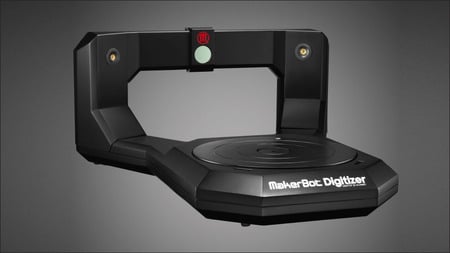We’re certain most of you have heard of MakerBot’s latest device: The Digitizer. It’s a relatively inexpensive 3D scanner designed for prosumer use. As the first 3D scanner that could hit a mass audience, we pondered what it might mean. What happens when large numbers of people own a 3D scanner. Here’s our predictions:
Thingiverse Overflows. Sure, you can add more storage, but watch out – Thingiverse, the largest free online repository of 3D models will almost certainly fill up with all manner of scanned objects. While only some people are skilled 3D modelers, many more will now be able to create 3D models at the push of a button. They’ll also be able to push the Thingiverse “upload” button.
Lawsuits. Everywhere. The scanner permits 3D copying of patented or licensed material. Expect an avalanche of Star Wars characters, Cars and replacement parts. Then expect an avalanche of cease and desist orders, followed by lawsuits.
Rigorous Rules. If lawsuits and takedowns occur frequently, expect the owners of online 3D repositories to change their terms of service to put the onus on uploaders to ensure their files are legal.
CAD Demand Increases. With all the 3D scans appearing, we expect at least some people will want to convert them into CAD files for modification. Therefore, there will be a slight uptick in power 3D modeling software and associated training.



It is inexpensive compared to commercial options, such as Creaform's, which can run from USD$30,000-75,000. Sure, it's nowhere near as capable, but it will do the job for consumers. The target market for this device is NOT makers like yourself who are capable of building a scanner from a kit; it's general consumers who just want to push a button. And they will.
It is inexpensive compared to commercial options, such as Creaform's, which can run from USD$30,000-75,000. Sure, it's nowhere near as capable, but it will do the job for consumers. The target market for this device is NOT makers like yourself who are capable of building a scanner from a kit; it's general consumers who just want to push a button. And they will.
"It's a relatively inexpensive 3D scanner designed for prosumer use", don't you mean "expensive" scanner? $1400 is why this scanner will FAIL, the forums and boards are lit up with outrage at the price for what essentially a "closed source" software option derived from open source apps, not to mention from what was once an open source company, and then charging outrageous prices for what is two line laser scanners (19.99 ea) and a 1.3 cmos, not even high def low quality, camera ($5-$10) along with some plastic, a stepper motor($25-$50) and a usb cable.
not to mention if you look at their "gnome" they is tons of detail loss all over, and I'm sure they scanned it at the highest settings. check out the belt buckle its lost its latch completely (red gnome picture)
I'll wait for either the other cheaper options to come out ($300-600) starting in september or go with a david3dscanner which is free if you provided your own hardware.
"It's a relatively inexpensive 3D scanner designed for prosumer use", don't you mean "expensive" scanner? $1400 is why this scanner will FAIL, the forums and boards are lit up with outrage at the price for what essentially a "closed source" software option derived from open source apps, not to mention from what was once an open source company, and then charging outrageous prices for what is two line laser scanners (19.99 ea) and a 1.3 cmos, not even high def low quality, camera ($5-$10) along with some plastic, a stepper motor($25-$50) and a usb cable.
not to mention if you look at their "gnome" they is tons of detail loss all over, and I'm sure they scanned it at the highest settings. check out the belt buckle its lost its latch completely (red gnome picture)
I'll wait for either the other cheaper options to come out ($300-600) starting in september or go with a david3dscanner which is free if you provided your own hardware.